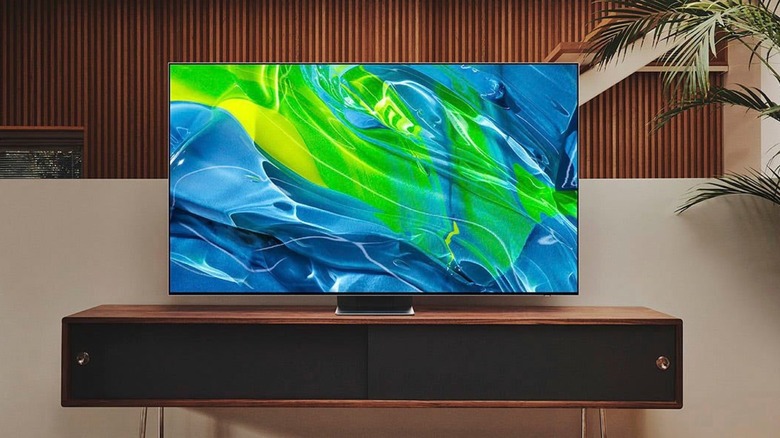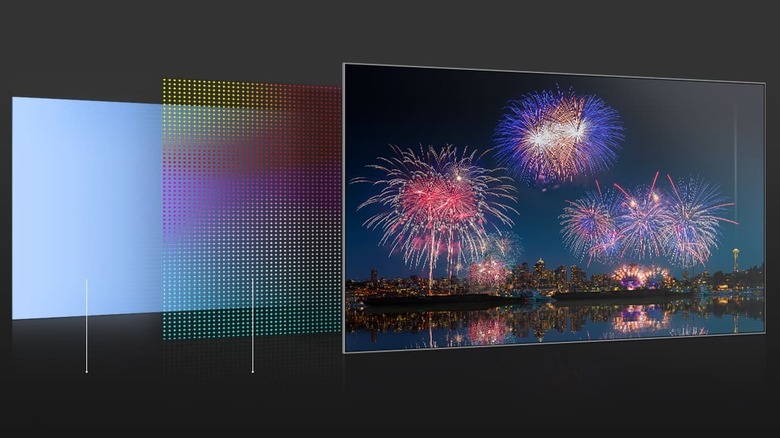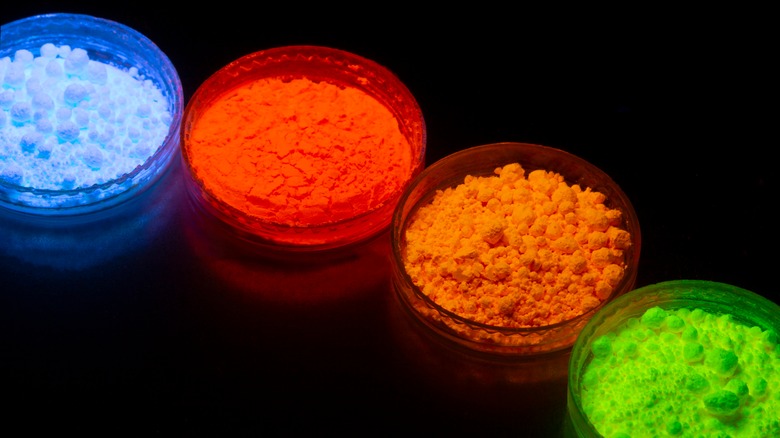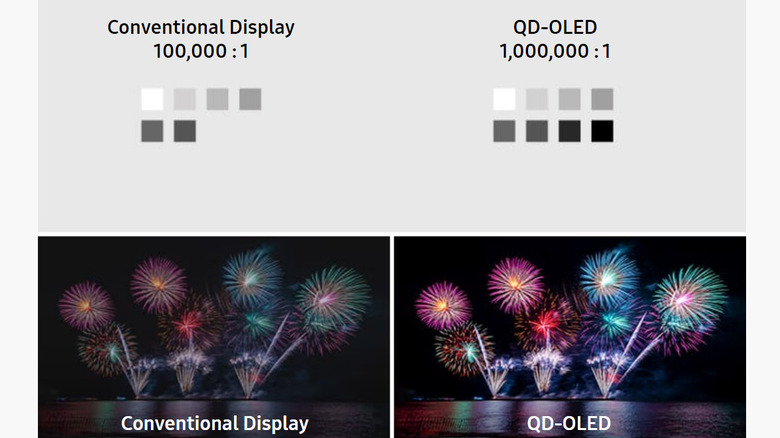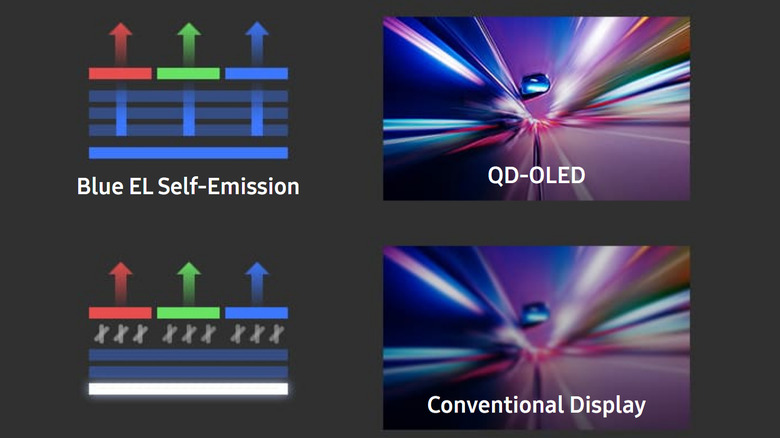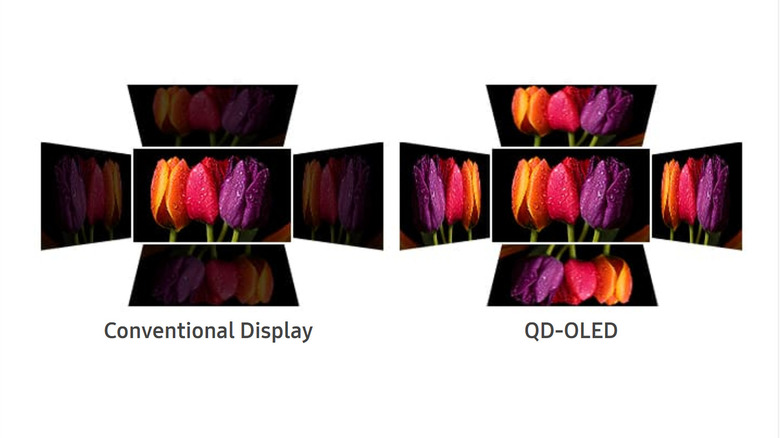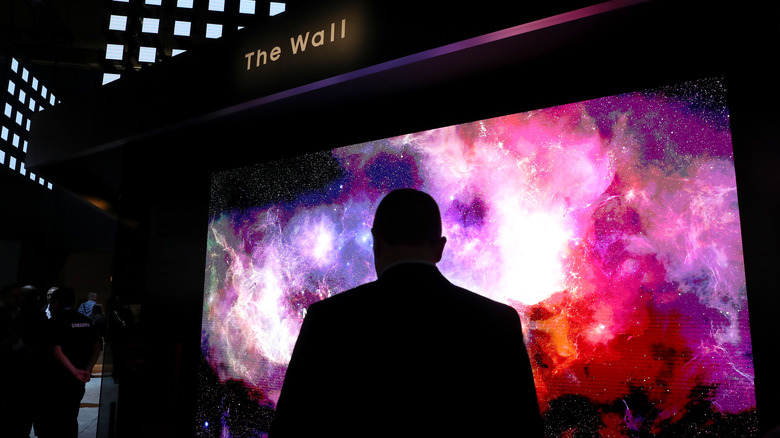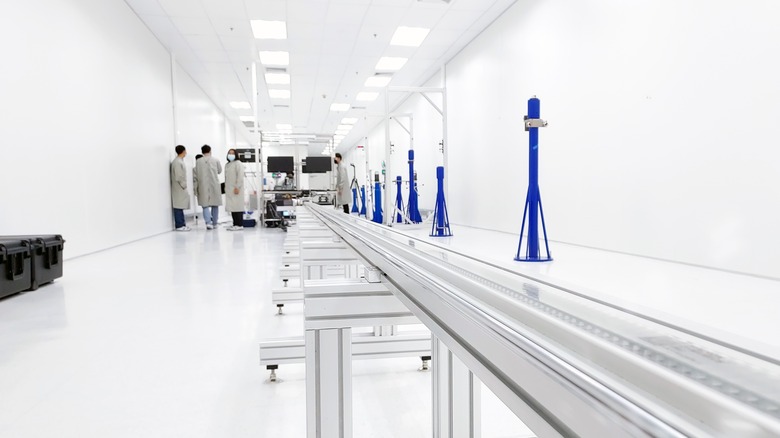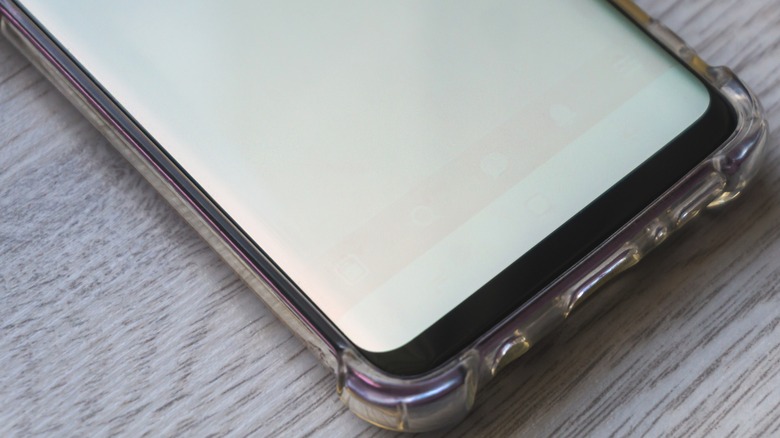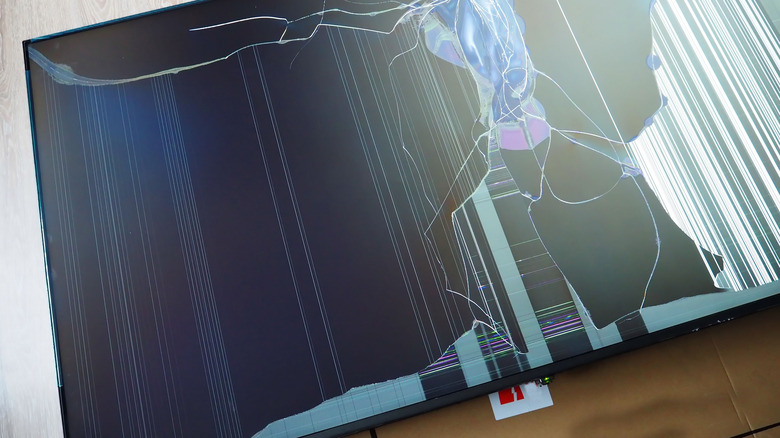5 Reasons QD-OLED TV Tech Is Worth Paying Attention To (And 5 Reasons It May Just Be A Fad)
We may receive a commission on purchases made from links.
After its first OLED TV attempt in 2013, the curved KN55S9C, which proved too complicated and expensive to mass-produce, Samsung bowed out of the OLED market. Since then, the company has been exclusively pushing its QLED technology, which puts quantum dots onto LED screens to bring high brightness and wide color. The company has even put out adverts bashing OLED technology and the risk of burn-in that the organic pixels are made from.
While the company wasn't releasing any OLED TVs, it was still working on OLED technology, both for larger screens and smartphones. In 2022, Samsung released QD-OLED to the world, putting quantum dots onto an OLED light-emitting layer to create a hybrid of the leading flat panel technology. The technology promises brighter screens than traditional OLED without needing the additional white pixel that panels from LG rely on. That sounds like a big deal, but what else can QD-OLED do? Let's dive in, and find out why you might want it and why you might want to give it a pass for the time being.
What Is QD-OLED, and how is it different?
QD-OLED combines the best parts of OLED panels and QLED, adding a quantum dot layer to emit primary red, green, and blue light without resorting to the color filter layer used on OLED. The whole panel is created by blue OLED pixels, stacked three deep to increase the overall brightness while reducing the effect of burn-in on any one pixel. A layer of red and green quantum dots is printed onto this layer as if you're printing ink onto a piece of letter paper.
Every pixel is self-emissive, generating its own light. Unlike LCD panel types, the light you see hasn't passed through anything else on its way to your eyes, enabling a level of color purity that no other panel type can match currently. The quantum dots are incredibly efficient, emitting almost all of the light energy they absorb from the blue layer below. Blue was chosen as it has the strongest light energy of OLED pixels, making every QD-OLED pixel more powerful than traditional OLED, which needs to pass its light through a polarizer, a color filter, and another polarizer before it comes out of the panel.
Wide color range - Worth it
Thanks to their self-emissive nature, OLED panels already have a wide color gamut. The technology used in normal OLED sends the light through color filters before it gets to your eyes. QD-OLED removes the necessity for any color filters, as the screen creates the colors directly. That translates to a "very high color purity," according to Samsung Display, one of the leading companies using the technology. In the BT2020 gamut, favored by moviemakers, normal LCD panels like IPS or VA cover 60% of the gamut or less. The QD-OLED panels cover almost the full BT2020 color space, an 80% increase over the coverage of conventional LCD panels.
You'll care because images will look more vibrant, even on standard settings. No more over-saturating the settings on your TV; instead, you'll see images as intended by the content creators. More coverage of the color space means it can display colors that were difficult to show on other panel types, making the image more lifelike.
Brighter than OLED - Worth it
OLED panels have a trade-off for their wide color range and near-infinite contrast range – brightness levels that are lower than other panel types. LG's newest OLED panel tech, which uses microlenses to focus the light for better brightness levels, has a maximum brightness of 1,200 nits. LG suggests that their upcoming LG G3 OLED TVs have tested internally at over 2,000 nits — these sets are expected to release in March of 2023. Current QD-OLED panels from Samsung top out at 1,500 nits, a significant increase. The only time the QD-OLED tech lags is with scenes of overall brightness, as the fullscreen white level is limited to 200 nits.
That was 2022's QD-OLED, first-generation panels. Samsung's back with its second generation for 2023, and they came out swinging. The new QD-OLED panels for this year now come in a 77-inch TV, along with 55-, 65-, and 34-inch. There's a 49-inch ultra-ultra-wide monitor for PC use, and all of them have new optimization algorithms to avoid burn-in. The new OLED HyperEfficient EL material improves every color's brightness, which enables a maximum brightness of 2,000 nits. That's higher than the Liquid Retina XDR mini-LED display on the iPad Pro 12.9", even if it doesn't get to the 4,000+ nits peak brightness of Samsung's Mini-LED TVs like the QN900B.
High contrast - Worth it
The self-emissive nature of every OLED or QD-OLED pixel means it can be turned off individually without it being affected by backlight bleed. That means true black levels, something no other consumer panel can offer. You could put fully-black pixels next to areas of color without noticing a halo effect around the black areas. The manufacturers love to call this "infinite contrast," although that's hyperbolic as you would need infinite bright white levels for that to truly happen.
QD-OLED can hit high brightness levels without losing any contrast, as the panels don't use the pure white pixel that current generation OLED panels use to boost brightness levels. Samsung Display says this gives QD-OLED a contrast ratio of 1,000,000:1 which is ten times higher than conventional LCD or LED display panels. That adds up to "deeper, more detailed image quality" and is easily seen in scenes with large amounts of black with bright objects like the fireworks in the image above.
Low input latency and fast response times - Worth it
The direct control over pixel signals promises that QD-OLED panels will have fast response times from the standard gray-to-gray measurements. Dell says that the Samsung panel on the Alienware AW3423DW has a 0.1ms gray-to-gray rating with a 175Hz refresh rate. For comparison, the gray-to-gray rating of the Alienware S3422DWG with a VA panel is 2ms. That's 95% faster if the technical specifications are to be believed. Other OLED panels also have fast response rates, like Corsair's bendable Xeneon Flex, which has a 0.03ms gray-to-gray rating. That will translate to smooth onscreen movement without ghosting or lag.
Input lag is also low on QD-OLED, lending itself easily to gaming use. Rtings has tested the Samsung S95B, the only Samsung QD-OLED TV available right now, and found it to have 5.4ms of input lag at 120Hz and 4K, the output of current-gen video games consoles like the PlayStation 5 and Xbox Series X. Some napkin math shows that's lower than the 8.3ms of the average frame time when the panel is running at 120Hz, meaning you should have lower than one frame of input lag at any time.
Wide viewing angle - Worth it
Flat panel TVs using IPS or VA technology have a problem – the further you get from the center line, the more the image degrades. According to Avantama, that degradation appears as "desaturated colors, washed-out black levels, and unusual optical properties." Nothing that you want when you're trying to get immersed in a blockbuster movie or cheer on your favorite sports team on the weekend.
Self-emissive panels like OLED give a higher off-axis quality of image than other technologies like LCD. Adding the quantum dot layer to OLED further improves this, with anti-reflective coatings improving transmissive properties and reducing the effect of ambient light and light from neighboring pixels on black levels or color accuracy. OLED has been tested to show no "diminished luminance capacities at angles of up to 84 degrees," QD-OLED should have an even higher rating due to how the quantum dot layer creates light. That means wherever you sit in your living room, you'll enjoy a similar image to sitting right in the centerline of the QD-OLED TV.
Still pales to MicroLED - Fad
Quantum dot film improves almost every aspect of OLED technology, making it brighter, more colorful, and wider color gamut. It's the best of the currently-available self-emissive screen technologies in consumer products, but a new panel type is waiting to take over. That upcoming technology is MicroLED, another screen type that uses individual LEDs for the pixels, just like OLED. Still, with no pesky organic material to break down, it can be brighter, last longer, and has no chance of burn-in.
It's not a new technology, with manufacturers like Sony, Samsung, and Apple working on their version of MicroLED for years. The difficulty is in the production, which is expensive, hard to scale to consumer product levels, and without consensus on the best way forward. One production method uses robots to place individual LEDs onto the panel, like a Lite-Brite. Another creates the LED pixel array and then transfers it onto an IC substrate for power and control. Both are expensive. Samsung's 110" MicroLED TV costs an eye-watering $149,997.99 to purchase. A new way promoted by Nanosys is to use blue LEDs with quantum dots printed on them in the same way that QD-OLED is produced. This would be cheaper to produce and still bring all of the benefits of MicroLED.
Still early in the development cycle - Fad
Displays using QD-OLED technology have only been around since the start of 2022. Samsung has led the charge to get its new panel technology into consumer devices, putting it into Alienware's 34" Ultrawide Gaming Monitor and its own Odyssey OLED G85SB and S95B OLED 4K Smart TV, all of which use quantum dots in conjunction with OLED. Sony has one QD-OLED TV, the A95K Master Series, which starts from $2,799.99. The company says it is better for cinematic content viewed in darker spaces.
Two TVs and two currently-available gaming monitors don't spell the end for other panel technologies at this point. Samsung is bringing out a QD-OLED ultra-ultra-wide later this year, the Odyssey Neo G9, which is 49" in width with a 32:9 ratio and a 1000R curve. Compare that to dozens of OLED monitors and TVs from companies like Corsair, LG, and Acer, and the market for QD-OLED is still in its early days. With MiniLED becoming more popular and MicroLED not far away from a consumer release, QD-OLED will have to grab a foothold on the market now; otherwise, it will lose out to the superior combination of MicroLED with quantum dots.
Still prone to burn-in - Fad
OLED has come a long way in the years since the burn-in issues of the iPhone X and Pixel 2 XL, but they are still prone to displaying ghostly images when static scenes are shown over a long period of time. Things like chyrons on news programs (the lower third with all the graphics and text) or the taskbar on your desktop PC tend to stick on the screen, especially if the brightness is higher. Manufacturers have developed various burn-in reduction routines to combat this on OLED screens, but it is still a problem.
QD-OLED is still prone to burn-in but at a reduced rate. It's all down to the structure of the OLED layer, which isn't a single layer but uses three pixels of blue OLED stacked to provide the necessary brightness levels while sharing the risk of burn-in. That reduces the chance any QD-OLED pixel will fail, reducing the chance any pixel will burn in to a given image. Combine that with the pixel and panel refresh routines that the manufacturers have developed, and burn-in is something you might not see in the time you have your TV or monitor.
Still more expensive (for now) - Fad
Any new panel technology is more expensive than those that came before. QD-OLED is still very new, and Samsung Display will take time to increase yields to the levels of QLED panels. Until then, the panels will be more expensive to manufacture, and that additional cost will get passed onto the consumer.
A report last year said that Samsung was internally squabbling with Samsung Display over how much they would pay for each QD-OLED panel. The story was that Samsung only wanted to pay comparable prices to those it was spending on OLED panels from LG. The big problem was that QD-OLED manufacturing was still in its early stages, with low yields. Another report from TechRadar said that only three out of every ten panels were viable for turning into consumer products. Compare that to the stats for LG's OLED panel manufacturing, which had a 65% yield in 2015, nearly a decade ago, and you get a picture of QD-OLED production processes that are likely more expensive to begin with and likely at a lower yield rate than the more mature OLED lines.
Still fragile - Fad
The blue layers of OLED that provide the initial light for QD-OLED panels are around 100-500 nanometers in thickness, "around 100 times thinner than a human hair." Even with three layers to share the brightness strain, that's still a very thin material. Each emissive layer also needs a substrate to keep it supported, often foil, plastic, or glass, so it can be transparent to allow for the light to emit.
Even though the layer is so thin, it's not as fragile as you'd think. LCD screens are fragile because of the crystal nature of the display panels and the glass sandwich that creates them. OLED and QD-OLED are both flexible, which enables devices like foldable smartphones to be durable enough for daily use. Impact damage can damage them, as regular posts on Reddit remind us, so be careful when plugging in cables so that the metal ends don't hit the panel. Other useful tips for avoiding damage include using two hands to move any arm-mounted QD-OLED panel and using more than one person to set them up or move them around the house.
